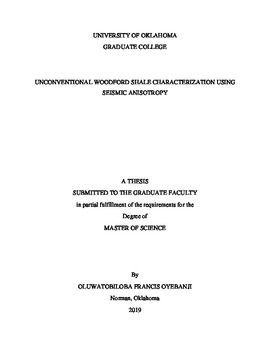| dc.description.abstract | Information on the geomechanical condition of the vertical and lateral heterogeneities in unconventional reservoirs is critical in designing completion programs for targets such as the 100 ft thick, 10,000 ft deep Woodford Shale. To address this problem, I use the azimuthal and offset information provided by a modern wide azimuth 3D seismic survey to map the variation in the elastic properties of the formation.
In the absence of direct measures of natural fractures in the borehole, I used measures of natural fractures in a suite of Gamma-Ray Parasequences (GRP) where the Woodford Shale outcrops 150 miles to the southeast of the seismic survey. I then correlated the outcrop GRPs to those seen in three wells in the Anadarko Basin target area to generate a lithology stack of the upper, middle, and lower Woodford Shale. subdivisions. Stiffness analysis results from Young’s modulus and Poisson’s ratio crossplots indicated the middle Woodford to be the stiffest of the three subdivisions, consistent with the higher chert content seen in the outcrop.
Without access to shear wave logs, I limited my inversion to poststack analysis, which showed the Woodford shale to be a low-impedance unit across the study area. Even after spectral balancing which increased the bandwidth 50% from 15-42 Hz to 12-84 Hz, there was insufficient resolution to separate the three Woodford subdivisions. Nevertheless, the seismic data were sufficiently good to apply modern AVAz analysis to estimate the anisotropy gradient (Baniso) and azimuth (φiso). Using the outcrop where the great majority of the natural fractures are confined to the chert-rich, laminated middle Woodford as our model, we assume the same fracture pattern continues into the area of the 3D seismic data. The AVAz analysis shows regions with high fracture intensity with orientations ~90° (E-W) and ~50° (NE-SW) corresponding to those identified in the Woodford Shale outcrop with bitumen filling. Because we are measuring the AVAz effect for the Woodford Shale as a unit, the areas of higher anisotropy indicate either more intense fracturing, a thicker middle Woodford, or both. | en_US |
